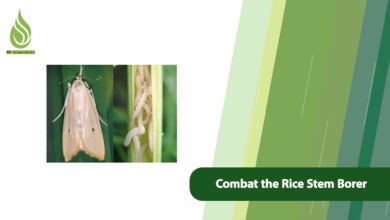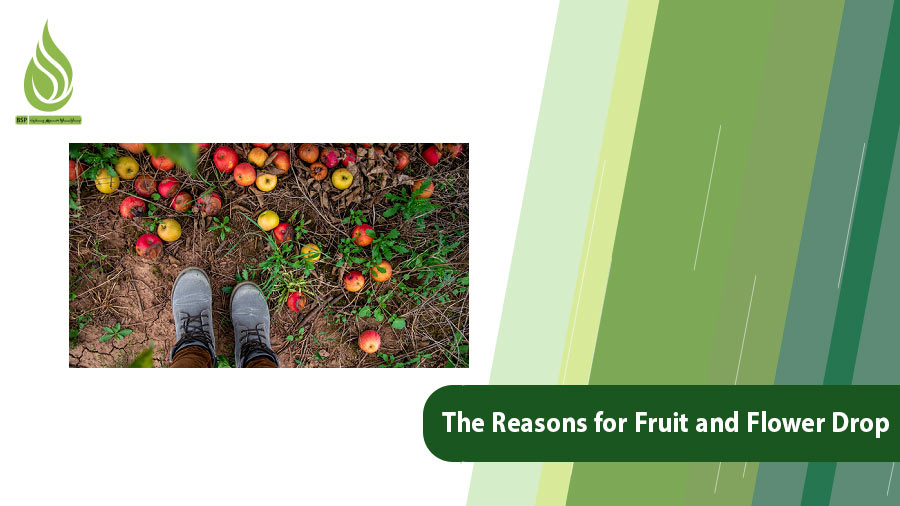
What are The Reasons for Fruit and Flower Drop and Its Solutions?
Fruit drop and flower drop, also known as ‘blossom drop’, present significant challenges for farmers and gardeners. Numerous factors can influence the flowering and fruiting of trees, and in this article, we delve into the key reasons behind these issues. By exploring the causes of fruit and flower drop, we aim to provide practical and effective solutions to help farmers and gardeners prevent and manage this common problem.
What Kind of Flower and Fruit Drop is Abnormal?
Each spring, fruit trees blossom before bearing fruit. These blossoms are fleeting, typically appearing in April and dropping in June as fruits begin to develop. However, there are instances where the premature shedding of blossoms signals an issue, leading to subsequent flower loss. This unnatural drop of flowers and fruits from trees can significantly impact agriculture. Usually, the premature shedding of tree blossoms is linked to factors such as inadequate nutrition, pollination challenges, environmental stressors, diseases, and pest infestations.
You might also witness fruits falling from trees before the expected harvest season commences. This occurrence is often tied to the tree’s nutritional intake. When a tree lacks essential nutrients, it struggles to retain fruits and flowers. Fruit drop can also be triggered by factors like water scarcity, excessive fruiting, and high temperatures. Therefore, it is essential to comprehend the root causes of fruit drop before devising solutions to prevent leaf and fruit loss.
What Causes Fruit and Flower Drop?
The dropping of flowers and fruits from trees is a significant worry for many farmers. Understanding the reasons behind fruit and flower drop can help prevent this issue. In this segment, we delve into the key factors that influence the dropping of fruits from trees.
Inadequate Pollination: A Barrier to Fruit and Flower Development
Among the pivotal phases in the life cycle of fruit-bearing trees is the process of pollination. This intricate process occurs shortly after flowering and plays a crucial role in fruit production. When pollination fails to occur, flowers deteriorate and drop prematurely. Weather conditions play a vital role during the pollination window. Factors like rain and cold temperatures can hinder the activity of pollinating insects, while excessively high temperatures can disrupt the pollination process. Moreover, improper irrigation, incorrect fertilization, insect infestations, and diseases can also impede proper pollination. Deficiencies in essential elements like zinc and potassium are among the factors contributing to inadequate pollination.
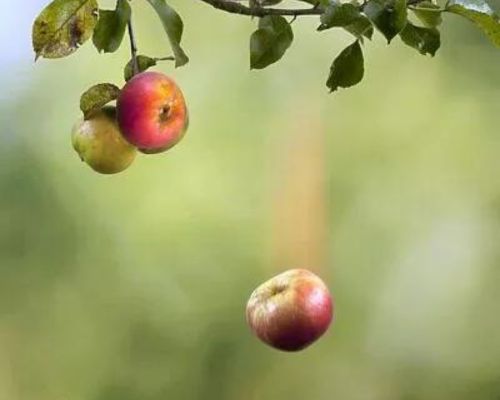
Incorrect Fertilization Practices
Plants and trees rely on nutrients to thrive and bear fruit. Insufficient essential elements and improper nutrition rank among the leading causes of fruit drop in trees. During the fruiting stage, trees allocate all necessary nutrients to their fruits for optimal growth; thus, trees need to receive the required nutrients for fruit development.
Just as nutrient deficiency hampers fruit growth, excessive fertilization can also lead to fruit and flower drop. Therefore, farmers and gardeners should understand the precise fertilization quantities and the specific fertilizers essential for tree health.
Nutrients like nitrogen, potassium, zinc, and boron are crucial for trees. These fertilizers play distinct roles in tree growth, leaf quality, flowering, and fruiting. Trees are fertilized using both organic and mineral fertilizers. Organic fertilizers are typically applied at the end of winter using a top-dressing method. On the other hand, chemical fertilizers are applied in stages from pre-flowering to post-harvest to ensure adequate nutrient supply.
To address the nutritional requirements of trees effectively, it’s crucial to identify any deficiencies and fulfill their nutritional needs following a well-structured feeding schedule and appropriate timing. Planning a nutrient regimen before signs of shedding manifest is key to optimal performance. The emergence of shedding symptoms signals a critical situation that can lead to economic losses.
Improper Watering
Insufficient or excessive watering stands out as a primary culprit behind flower and fruit drop in trees. To combat this issue, avoid flooding the trees with water. Overwatering creates a fertile environment for fungi and diseases to thrive. Consistent and appropriate watering plays a vital role in enhancing fruit yield and quality. Therefore, it’s essential to establish a consistent watering routine tailored to the specific tree species and its requirements. Adequate drainage is also crucial to prevent root saturation, tree decay, and infections.
Pests and Diseases
The onslaught of pests and diseases can stunt fruit and blossom growth and lead to their premature drop. Fungal and bacterial infections, along with pests like aphids and mites, are common culprits behind agricultural losses. These invaders sap significant energy from plants, leaving them unable to thrive; as a result, trees shed fruits and flowers to conserve energy and reduce weight.
When trees are under pest attack, watering can inadvertently worsen the infestation. In such cases, spraying becomes necessary to combat the invaders. If you lack gardening expertise, seek guidance from a seasoned agricultural professional before applying pesticides to identify the right type and dosage for effective pest control.
Influence of Environmental Factors and Regional Climate on Fruit and Flower Drop
Environmental elements play a significant role in fruit and flower drop in trees. Factors such as strong winds, low or high temperatures, and excessive humidity can trigger the premature shedding of flowers and fruits. Additionally, the genetic makeup of a tree can impact fruit drop, as certain varieties may be more vulnerable to environmental conditions that are incompatible with the local climate. It’s advisable to select tree varieties that are well-suited to the region’s climate when planting seedlings.
In regions with mountainous terrain and cold climates, blossom drop is a common occurrence, especially when cold spells hit early in the growing season, leading to the loss of a substantial number of blossoms. Furthermore, spring rain and hail can also contribute to flower drop.
Trees that bloom later are typically less susceptible to environmental factors and regional climate influences that cause fruit and flower drop. Excessive rainfall in an area can create a breeding ground for pests and diseases, compounding the issue of blossom drop.
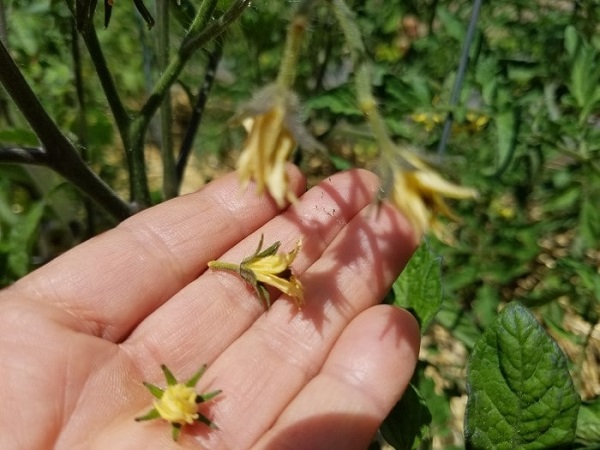
Managing Tree Fruit and Flower Drop: Effective Strategies
Controlling the premature shedding of fruit and blossoms in trees involves paying attention to various key factors:
- Regular Watering: Ensuring trees receive sufficient and consistent watering can alleviate plant stress and minimize fruit and flower drop.
- Proper Nutrition: Utilizing appropriate fertilizers can bolster tree health, fortifying flowers and fruits against premature drop.
- Pest and Disease Control: Regularly inspecting trees for pests and diseases and employing suitable control measures can thwart fruit drop.
- Fruit Management: Avoid excessive fruit production to curb fruit drop. Pruning trees to maintain a balanced fruit-to-tree capacity ratio is essential. Trimming trees and removing diseased or dead branches promotes tree health, ensuring robust fruit production in subsequent seasons.
- Utilization of Plant Hormones: Plant hormones like ethylene can be effective in regulating fruit drop. Seeking guidance from experts in this field can be beneficial.
- Mitigating Environmental Stress: Enhancing environmental conditions such as light exposure, temperature, and humidity can alleviate tree stress, reducing the likelihood of fruit and flower drop.
- Harvest Timing Adjustment: Harvesting fruits at the optimal time can help minimize fruit drop, ensuring a more successful yield.
By implementing these strategies and staying proactive in tree care, you can effectively manage fruit and flower drop, promoting healthy and fruitful tree growth. When the primary reason behind flower and fruit drop remains elusive, seeking assistance from a seasoned farmer or agricultural expert is advisable. Their expertise can help pinpoint the root cause of the issue and implement appropriate control strategies promptly.
What’s the Ideal Fertilizer to Prevent Fruit Drop?
Preventing fruit drop hinges on the judicious use of suitable fertilizers to nourish trees and plants effectively. Selecting the right fertilizer for trees is no simple feat—it requires consideration of factors such as tree type, local climate, rainfall levels, and the tree’s fundamental requirements. A crucial step in this process is conducting a soil test before fertilizing. Soil testing reveals the soil’s nutrient and mineral composition, enabling the application of the necessary fertilizers tailored to the tree’s specific needs.
Let’s delve into the key fertilizers essential for averting the premature shedding of blossoms and fruits from trees.
Nitrogen Fertilizers: Boosting Tree Strength to Prevent Fruit and Flower Drop
A weakened tree stem can be a contributing factor to fruit drop, emphasizing the importance of fortifying the tree’s structure to better support its fruit-laden branches. Nitrogen plays a crucial role in promoting leaf and branch growth, thereby enhancing overall plant strength and fruit yield. Insufficient nitrogen levels can lead to stunted flower growth, increasing the likelihood of flower drop.
However, it’s essential to be cautious with nitrogen-rich fertilizers during the flowering and fruiting seasons. Excessive nitrogen content in fertilizers can prompt the tree to prioritize vertical growth, focusing on leaves and branches rather than fruit development. This shift may halt fruit and blossom growth, redirecting the tree’s energy towards vertical expansion. For optimal results during the fruiting phase, opt for nitrogenous fertilizers with a balanced nitrogen content to support healthy fruit production.
Ammonium sulfate stands out as a nitrogen-rich fertilizer that plays a vital role in supplying the necessary nitrogen levels required by plants throughout the fruit growth period. With a nitrogen content of 21% and sulfur content of 24%, this fertilizer offers a well-balanced blend that delivers 100% appropriate nitrogen support, effectively aiding in the prevention of flower and fruit drop.
Ammonium sulfate fertilizer, serving as a nitrogen source, extends the longevity of ovules or pistils within plants. Additionally, nitrogen-rich fertilizers can expedite the development of pollen tubes, facilitating smoother and more efficient pollination processes.
Enhancing Fruit and Flower Health with Potassium Fertilizers
Potassium plays a crucial role in enhancing fruit quality and fortifying plants against stressors. The strategic use of potassium fertilizers can effectively combat fruit drop and flower drop. Fertilizers enriched with potash stimulate increased flowering in trees, promoting a more robust bloom. Moreover, potassium boosts plant resilience against diseases and pests. Conversely, a potassium deficiency can weaken flower stems, leading to premature flower shedding.
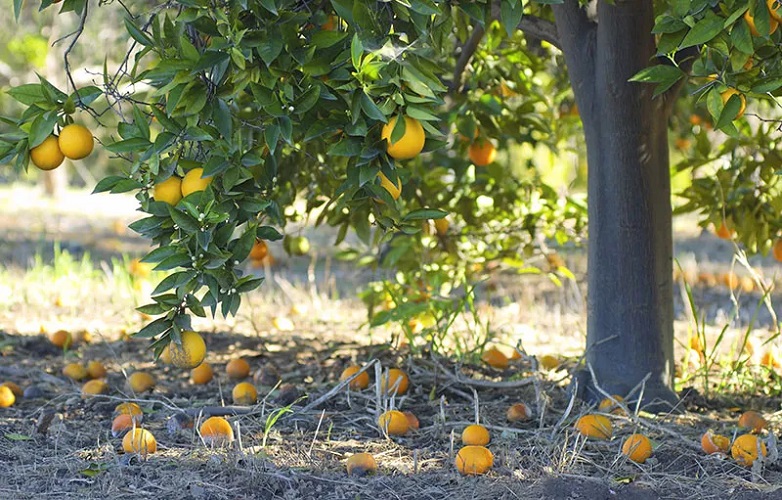
Boosting Flower and Fruit Health with Phosphorus Fertilizers
Phosphorus plays a vital role in the development of flower buds, blossoms, and root growth. A scarcity of phosphorus can lead to weakened flowers and premature flower drop. Incorporating phosphorus-rich fertilizers like superphosphate can significantly enhance fruit production. By utilizing fertilizers with phosphorus content, you can augment both the quantity and size of flowers, promoting healthier and more abundant blooms.
Micronutrients
Micronutrients are pivotal for nurturing flowers and preserving fruits on trees. Among these micronutrients, boron, and zinc stand out as key players in maintaining the vitality of flowers and fruits. Insufficient levels of these elements can lead to physiological imbalances and a decline in fruit production.
Boron: Insufficient boron levels can disrupt pollination and fertilization processes, contributing to fruit drop. Boron aids in accelerating pollen tube formation, facilitating early pollen transfer to the pistil for successful fertilization. It also enhances the viability of pollen grains. A boron deficiency can result in fruit failure and increased flower drop.
Zinc: Inadequate zinc levels can be a factor in fruit drop or poor fruit development. Zinc plays a crucial role in pollen development, fertilization, and fruit maturation. A shortage of zinc may manifest in undersized leaves, misshapen fruits, reduced yields, and increased fruit drop.
Expert Tips to Prevent Flower and Fruit Loss in Trees
- Opt for organic fertilizers like animal manures and composts to nourish your trees naturally.
- Timing is key—fertilize during late winter and early spring to provide essential nutrients for robust flowering and fruiting.
- Avoid uncomposted animal fertilizers to steer clear of pests and diseases.
- Fertilize before flowering to support the tree’s nutrient needs for blossoming. A second round after the initial flower drop can fortify the remaining flowers and boost yields.
- Utilize methods like chalking and foliar spraying for targeted tree fertilization. Chalking is typically done in winter, while foliar spraying aligns with tree germination and post-flower drop phases.
- Tailor fertilization timing to your tree type to combat flower and fruit drop effectively. Seek advice from agricultural experts for optimal results.
- Conduct a soil test before fertilizing to tailor nutrients to your trees’ requirements accurately.
- Avoid excessive fertilizer use, which can lead to fruit drop; moderation is key.
- Prune trees thoughtfully in winter to promote light and air circulation, aiding nutrient distribution and reducing flower loss.
- Water trees appropriately to prevent nutrient leaching—adjust irrigation schedules based on tree species to avoid water stress.
- Remove weak or damaged fruits to redirect the tree’s energy towards healthier fruit production.
- Consider consulting with specialists on hormone use to regulate shedding effectively, tailoring hormone type and dosage to your tree’s specific needs.
